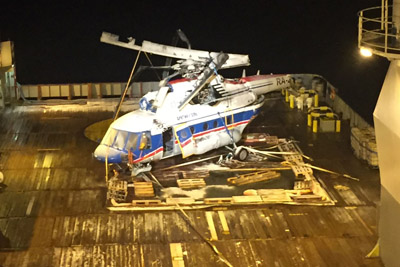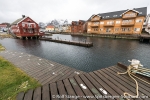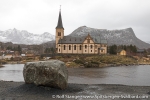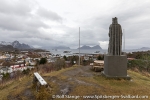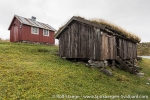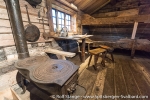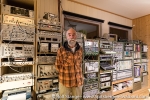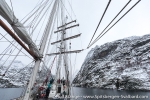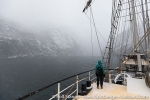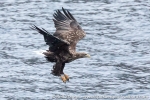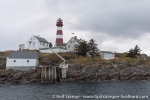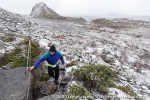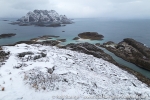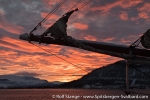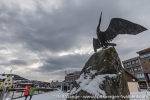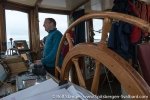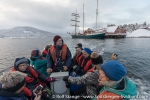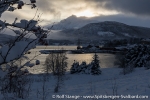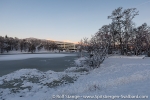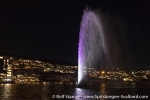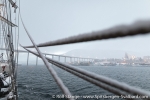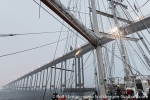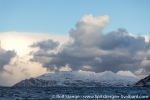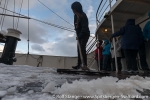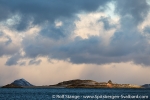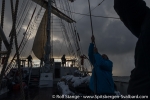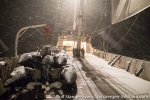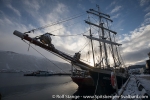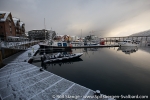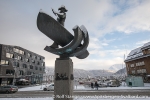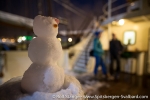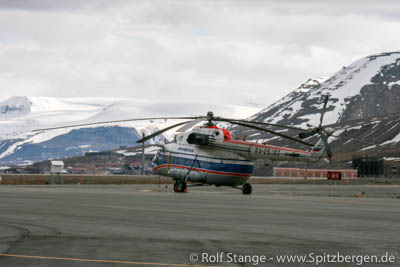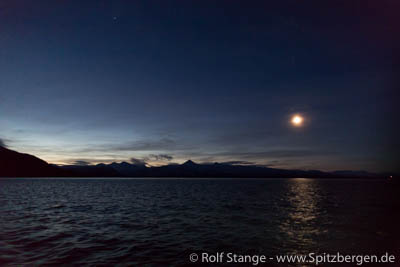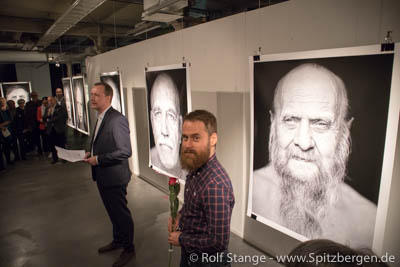-
current
recommendations- Liefdefjord
New page dedicated to one of Spitsbergen's most beautiful fjords. Background information and many photos.
- New Spitsbergen guidebook
The new edition of my Spitsbergen guidebook is out and available now!
- Liefdefjord
New page dedicated to one of Spitsbergen's most beautiful fjords. Background information and many photos.
Seitenstruktur
-
Spitsbergen-News
- Select Month
- April 2024
- March 2024
- February 2024
- January 2024
- December 2023
- November 2023
- October 2023
- September 2023
- August 2023
- July 2023
- June 2023
- May 2023
- April 2023
- March 2023
- February 2023
- January 2023
- December 2022
- November 2022
- October 2022
- September 2022
- August 2022
- July 2022
- June 2022
- May 2022
- April 2022
- March 2022
- February 2022
- January 2022
- December 2021
- November 2021
- October 2021
- September 2021
- August 2021
- July 2021
- June 2021
- May 2021
- April 2021
- March 2021
- February 2021
- January 2021
- December 2020
- November 2020
- October 2020
- September 2020
- August 2020
- July 2020
- June 2020
- May 2020
- April 2020
- March 2020
- February 2020
- January 2020
- December 2019
- November 2019
- October 2019
- September 2019
- August 2019
- July 2019
- June 2019
- May 2019
- April 2019
- March 2019
- February 2019
- January 2019
- December 2018
- November 2018
- October 2018
- September 2018
- August 2018
- July 2018
- June 2018
- May 2018
- April 2018
- March 2018
- February 2018
- January 2018
- December 2017
- November 2017
- October 2017
- September 2017
- August 2017
- July 2017
- June 2017
- May 2017
- April 2017
- March 2017
- February 2017
- January 2017
- December 2016
- November 2016
- October 2016
- September 2016
- August 2016
- July 2016
- June 2016
- May 2016
- April 2016
- March 2016
- February 2016
- January 2016
- December 2015
- November 2015
- October 2015
- September 2015
- August 2015
- July 2015
- June 2015
- May 2015
- April 2015
- March 2015
- February 2015
- January 2015
- December 2014
- November 2014
- October 2014
- September 2014
- August 2014
- July 2014
- June 2014
- May 2014
- April 2014
- March 2014
- February 2014
- January 2014
- December 2013
- November 2013
- October 2013
- September 2013
- August 2013
- July 2013
- June 2013
- May 2013
- April 2013
- March 2013
- February 2013
- January 2013
- December 2012
- November 2012
- October 2012
- September 2012
- August 2012
- July 2012
- June 2012
- May 2012
- April 2012
- March 2012
- February 2012
- January 2012
- December 2011
- November 2011
- October 2011
- September 2011
- August 2011
- May 2011
- April 2011
- March 2011
- February 2011
- January 2011
- December 2010
- November 2010
- September 2010
- August 2010
- July 2010
- June 2010
- May 2010
- April 2010
- March 2010
- February 2010
- November 2009
- October 2009
- August 2009
- July 2009
- June 2009
- May 2009
- April 2009
- March 2009
- February 2009
- January 2009
- December 2008
- November 2008
- October 2008
- August 2008
- July 2008
- June 2008
- May 2008
- April 2008
- March 2008
- February 2008
- April 2000
- Select Month
-
weather information

| THE Spitsbergen guidebook |
Home →
Yearly Archives: 2017 − News & Stories
Russian helicopter wreck lifted
The wreck of the Russian helicopter that crashed into Isfjord close to Barentsburg previous Thursday was lifted last night. The special ship Maersk Forza was brought to Spitsbergen for this task and completed the work successfully on the night from Friday to Saturday. There were 8 persons on board the MI-8-helicopter when it crashed, including 5 crew members and 3 scientists. One body had already been found some days ago about 130 m away from the wreck. There is no trace so far from the other crew members, and the search for them will be continued.
The cockpit voice recorder could secured together with GPS units which are expected to have the actual flight track saved. They will be brought to Moskva for further investigations.
Meanwhile, questions are raised regarding the cause of the crash and the circumstances of the flight. The data recorders that were secured are likely to shed light on the actual crash. It seems that the flight was not legal according to applicable Norwegian legislation. The Norwegian flight permit issued to the operator covers only flights in direct combination to the operations of the mining company Trust Arktikugol, for example transport of company employees between Longyearbyen and Barentsburg. Commercial flights and transportation of tourists and scientists are explicitely excluded.
There were 3 scientists on board the helicopter when it crashed.
The wreck of the Russian helicopter, which crashed on October 26 close to Barentsburg into Isfjord, on board the ship Maersk Forza (photo © SHT).
Source: Svalbardposten
Kabelvåg-Svolvær-Laukvik – 03rd November 2017
Fri
3 Nov
2017
The wind had become even stronger during the night, so we were quite happy to be already in the harbour of Kabelvåg. It is much nicer to go for a little walk and to visit the Lofotmuseum or the Lofotaquarium. Hats off to the group who went for the hike from Kabelvåg to Svolvær in wind, rain, very wet terrain and approaching darkness!
Unfortunately, the harbour master had ordered us to a remote corner of the industrial harbour of Svolvær, for reasons unknown to me. The way to Svolvær downtown, following the E10 over a bridge and through a tunnel, is not exactly what I consider northland romantic. Considering the rather poor weather, many preferred the cosiness of the ship above a walk anyway.
But in the evening, we went to the northern light entre in Laukvik to enjoy the hospitality and the presentation of Rob and Threes in cosy atmosphere (inside; the atmosphere outside was rather unpleasant). Everybody knew everything about coronal holes, solar wind, magnetosphere, activity levels etc. after the lecture, without any doubt!
Gallery – Kabelvåg-Svolvær-Laukvik – 03rd November 2017
- gallery anchor link: #gallery_1330
Click on thumbnail to open an enlarged version of the specific photo.
It did actually clear up a little bit later on. The bus ride back to Svolvær was a scenic pleasure, with the light of the full moon on mountains, fjords and lakes. It would have been nice to stop to put the tripod up. But just enjoying it was also nice! No northern light showed up during that evening, unfortunately. Well, we were obviously not up for that bit of luck.
Trollfjord-Skrova – 02nd November 2017
Thu
2 Nov
2017
The wind in Raftsund, where we had anchored for the night, was really strong, but it became a bit less in the early morning. The combination of the fjords and islands, rugged mountains, wind and snow made a very true and scenic impression of this harsh nature: wild and beautiful. This is how nature often is in the far north. Of course, there is sometimes a blue, sunny sky and calm water. But this here is normal life. Wild and beautiful.
„Wild“ and „beautiful“ changed in Trollfjord by the minute, as the snow squalls came and went. From zero visibility to clear views of the mountains, from calm waters to screaming winds within moments.
We were just about to leave when a whole family of 3 sea eagles came along. Several times, they flew past the ship in close distance. Good fun to have a fast camera now 🙂
Gallery – Trollfjord-Skrova – 02nd November 2017
- gallery anchor link: #gallery_1328
Click on thumbnail to open an enlarged version of the specific photo.
The attributs „wild“ and „beautiful“ were also an appropriate description of our afternoon visit to Skrova. Entering the harbour between all those rocks and skerries is always impressive, and then we were alongside. Soon we were ready for take-off to explore this lovely little island, walking through the little settlement around the harbour, across the island to some beautiful little bays with white sand beaches. Wind, cold, snow and approaching darkness could not keep some brave hikers to ascend Skrovafjellet. The reward came in shape of stunning views over the sea and islands.
We made the short passage to Kabelvåg in the evening. The forecast for tomorrow promised more wind, so it was good to get there today.
Harstad – 01st November 2017
Wed
1 Nov
2017
The history of the area goes back thousands of years, and it has got many chapters, most of them rather unpleasant. We had a look at some of that during the morning’s excursion to the Trondenes peninsula.
The Adolf gun (they really use that term in public) was part of Hitler’s fortification of the Atlantic coast. The sheer dimensions and the technology of this large cannon are as impressive as its background: people do obviously not save any effort or money when it comes to destroying something. If they only put a fraction of that effort and money into making things better … well. At least, the Adolf gun was never fired in anger, only for testing and practising.
Nearby Trondenes Museum took us through centuries of local history. Stone age hunters and fishers, vikings, early Christians, stockfish trade and so on.
Gallery – Harstad – 01st November 2017
- gallery anchor link: #gallery_1326
Click on thumbnail to open an enlarged version of the specific photo.
Directly upon leaving, the sails went up. Soon we thought we might have to take them down again after no time, as we were almost stationary in the straits northeast of Harstad. But then, the wind came back, more sails went up, and we got a lovely and exciting bit of sailing, I mean real sailing, up to a good 10 knots. A quick turn – the coast just did not want to move, so we had to – and finally the wind died down again and the took the sails down. Just in time for the bridge at Risøysund, which is always good for an interesting passage (bridge height 30 metres, height of Antigua’s main mast: 31 meters. So that works!).
Gibostad-Finnsnes-Harstad – 31st October 2017
Tue
31 Oct
2017
Gibostad welcomed us with a bit of a surprise: this nice, snow-covered, historical pier where we had gone alongside was close for traffic. Too old, not safe. So there was no evening walk.
But of course we wanted to have a look at the place, so we just use the zodiac to go ashore in a small boat harbour around the corner. A pittoresque little ville on the beautiful island of Senja, with an „old city“ at the small boat harbour. The „nostalgic bakery“ was closed, unfortunately 🙂 but that was not the point. The point was the beautiful landscape, the stunning light, the snow, all the lovely little details to discover. It was all there.
Also in Finnsnes, we took the opportunity to have a look around. A calm, small north Norwegian town. Not the centre of the world, but if that is what you are looking for, then north Norway is not your place anyway. But again, lovely evening colours (at 3 p.m.!) on the mountains, and a little, already frozen lake in a small forest in the middle of town.
Gallery – Gibostad-Finnsnes-Harstad – 31st October 2017
- gallery anchor link: #gallery_1324
Click on thumbnail to open an enlarged version of the specific photo.
The stunning evening light stayed with us until it gave way to twilight and then darkness. The sky remained clear, so we were of course curious what the evening might bring. The aurora forecast was not exactly optimistic, but so what, after all it was just a forecast! Reality is still a different thing. And indeed, later in the evening, there was a northern light! Faint, but clearly visible at times!
By the way, this website has got its own info site about northern lights, including some northern light photo tips from Rolf.
Helicopter crash: wreck soon to be lifted
The wreck of the Russian helicopter that crashed into Isfjord last week was identified on photos taken by a dive roboter from the research vessel Ossian Sars. The MI-8 helicopter is lying on the sea floor at a depth of 209 metres in Isfjord, about 2 km from the Russian helicopter base at Heerodden close to Barentsburg.
One body was found in a distance of 130 metres to the wreck. It is already in Longyearbyen. There is no hope that any of the 8 people in the helicopter, 5 crew and 3 scientists, survived.
The Norwegian authority for traffic disasters (Statens havarikommisjon for transport, SHT) is now in charge of further investigations. A salvage vessel is expected to arrive in Longyearbyen on Thursday. The uplifting operations will start as soon as the vessel is in position at the accident site. Russian specialists are in Longyearbyen to support the Norwegian forces under Norwegian leadership. When the wreck is lifted, it will be taken to the Norwegian mainland for further investigations. SHT is currently conducting interviews with witnesses and collecting various data including weather, the condition of the helicopter, qualification of the crew and more.
Photo by a dive roboter of the research vessel Ossian Sars used to identify the wreck (image © G.O. Sars).
Source: SHT
Kvaløya-Senja – 30th October 2017
Mon
30 Oct
2017
We left from Tromsø in good spirits in the early morning and set course to the north, through Kvalsund and to the outer side of Kvaløya, the large island west of Tromsø. The first orca of the season had been seen there a couple of days ago, so there was reason to be optimistic.
We were there at the right time but not quite at the right place, they were certainly somewhere, but not where we were, so we did not see any whales. We saw stunning landscape, rugged islands, sometimes hidden under snow showers, to re-appear then under quickly changing but always amazing light. We crossed 70 degrees north, close to Sandøya, an island with some lovely sand beaches and some lonely houses. Sandøya is supposed to have exactly one permanent inhabitant.
- gallery anchor link: #gallery_1322
Click on thumbnail to open an enlarged version of the specific photo.
Then we set a southerly course and sails, and the bridge crew took us safely through the skerries and rocks on the outer side of Kvaløya. We abandoned the plan to follow the outer side of Senja to Gryllefjord, it was just a bit too rough for that, and some had already sacrificed to King Neptune, so we went into the channels again and found good shelter between Senja and the mainland and soon we went alongside in Gibostad for a calm night.
Tromsø – 29th October 2017
Sun
29 Oct
2017
How do you see that the summer is over? When Antigua is back in Tromsø after several months in Spitsbergen. When the sun is going down under the horizon at 3 p.m. When you have to clean the snow away on deck 5 times a day. When you see a lot of old friends from Spitsbergen alongside in the harbour in Tromsø: the Cape Race, the Polargirl, the Aurora Explora, they are all here. Good old Norderlicht is alongside Antigua.
The light comes and goes with the snowshowers, grey clouds alternate with soft sunlight. Sometimes there is no visibility at all, sometimes the colourful wooden houses are reflected on the mirror-like water surface. People are coming to the ship through the snow one by one, handing bags and suitcases over before they come on board. Then we are complete, passengers and crew. We gather in the salong, welcome on board! We talk about life on the ship and the plans for the upcoming days and enjoy the first dinner of the trip. Sascha has prepared salmon. Good stuff!
Gallery – Tromsø – 29th October 2017
- gallery anchor link: #gallery_1320
Click on thumbnail to open an enlarged version of the specific photo.
After dinner, we talk about northern light photography and have a look at the cameras. It is completely cloudy now, but we have got a whole week, so there are very realistic chances for a clear evening and then … fingers crossed!
Helicopter crash: wreck found
The wreck of the Russian helicopter that went missing on Thursday afternoon is now most likely found. A ROV (Remotely Operated Vehicle) of the Norwegian Navy has localized an object at a depth of 209 metres on the sea floor that appears to be the wreck of the MI-8 helicopter. The ROV named “Hugin” and another ROV of the research vessel Ossian Sars will continue to gather data to identify the object and to find the missing persons. There were 8 people in the helicopter when it crashed on Thursday. No traces of survivors could be found.
The position is 2.2 kilometres northeast of the Russian helicopter base at Heerodden close to Barentsburg.
A Russian aeroplane has brought divers and other specialists from Russia to Longyearbyen to take part in the operation under Norwegian leadership.
Diving roboter Hugin of the Norwegian navy searching after the crashed helicopter near Heerodden.
Sources: NRK, Svalbardposten
Helicoptercrash: little hope to find survivors
There is no certainty yet if the object that was located by echolot in a depth of 200-250 metres on the sea floor in Isfjord, not far from the Russian helicopter base at Heerodden close to Barentsburg, actually is the wreck of the helicopter. But there is no doubt that the MI-8 helicopter did crash into Isfjord yesterday. As more than 20 hours have gone by since the crash and there is no trace yet of any survivors, hopes to find any of the 8 people on board are getting smaller and smaller and the worst has to be feared.
Names of the 8 persons on board were already yesterday released by Russian media. Now, also the responsible Norwegian authority, the Rescue Centre North Norway, has released the names officially.
The persons on board the helicopter were
Passengers (Scientists of the Instituts for Arctic and Antarctic Research in St. Petersburg):
Oleg Golovanov
Nikolaj Fadejev
Maksim Kaulio
Crew:
Jevgenij Baranov – Chief pilot
Vladimir Frolov – Second pilot
Aleksej Pouljauskas – Mechanic
Marat Mikhtarov – Technician
Aleksej Koroljov – Engineer
There is hope until the opposite is proven, and every effort is taken to continue the search and find survivors. Norwegian SAR forces are on location with helicopters, a special aeroplane from the Norwegian airforce, ships and boats. But the more time is going by, the more likely it seems that it is a tragedy without survivors.
The Sysselmannen has established a contact phone number for relatives and expresses deep sympathy with those who are affected. This is shared by the author of these lines, whose thoughts and sympathy are also with those who were in the helicopter and their family, friends and colleagues and all others who are involved.
According to international law, Norwegian authorities are responsible for the investigation of the accident. A havary commission is already in Longyearbyen and will soon start to gather all information that is available. But currently, the effort to find survivors and the helicopter are still the focus of all efforts.
Russian MI-8 helicopter at the airport Longyearbyen (archive image).
Source: Sysselmannen, Svalbardposten
Crashed helicopter probably found
The Russian helicopter that crashed on Thursday afternoon is probably found. Search-and-rescue forces sensed a strong smell of fuel and saw air bubbles coming to the water surface at a certain position in the area in question, in Isfjord, about 2-3 km from the helicopter base at Heerodden. A ship has found an object on the sea floor with the echolot that could be the wreck of the helicopter or a part of it. This needs to be confirmed, though. The depth is between 200 and 250 metres, far beyond the reach of divers.
Already during the night, a diving robot (ROV = Remotely Operated Vehicle) was brought from mainland Norway to Longyearbyen with a SAS plane. The ROV will be operated at the alleged accident site as soon as possible. This has probably already happened at the time of writing (08.30 local time on Friday morning) or it may be going on right now.
There were 8 persons on board the helicopter, and the search after survivors is going on. SAR forces are searching the nearby coast, east of Heerodden. Helicopters and ships are scanning the water. According to all that is known, the worst has to be feared, but all efforts are taken to find survivors. The Russian helicopter was of the type MI-8, which is equipped with a life raft and with lifting bodies that keep the helicopter afloat at least for a while in case of a controlled emergency landing on the water surface. The fact that no emergency signal was released by the crew makes it however doubtful that it was a controlled emergency landing. A sudden, uncontrolled crash seems likely. Witnesses say they have heard a loud noise like a bang at the time in question.
Next to the 2 Norwegian SAR helicopters, there is a number of ships and boats in the area: Polarsyssel (Sysselmannen), coast guard and boats from the tourism industry in Longyearbyen. Initially, the visibility was reduced by snow fall, but the weather is by now quite good, with little wind and clear visibility. The polar night has begun a couple of days ago, so even around noon, the sun remains below the horizon, making light very scarce.
Light conditions in Isfjord during the polar night around noon. The bright light is the moon. (Archive image.)
Source: Svalbardposten
Russian helicopter crashed near Barentsburg
There will be updates (see bottom end of this article) as further information becomes available.
A Russian MI-8 helicopter crashed near Barentsburg and fell into the sea in Isfjord. The helicopter was on the way from Pyramiden to Barentsburg with 8 persons on board.
The emergency call from the airport tower Longyearbyen was received at 15.35 local time by the emergency response centre North Norway. Norwegian search and rescue (SAR) forces are on location with helicopter and ships. The crash site is in the Isfjord, 2-3 kilometres away from Heerodden, the Russian helicopter base at Barentsburg.
No information is currently available regarding the condition of the 8 persons on board. There is a breeze (7-8 m/s) and the visibility is affected by snowfall.
According to Norwegian law, the Russian helicopters in Spitsbergen are only allowed to fly for company purposes. Charter flights, for example for film teams or scientists, are not permitted. This makes it likely that the 8 people on board were employees of the owner of the helicopter, Trust Arktikugol.
Update: next to the pilot (Baranov Evgeny), co-pilot (Frolov Vladimir), flight engineer (Alexei Poulyauskas), a technician (Mihtar Marat), and an engineer (Korolev Aleksey), there were 3 scientists of the Institute for Arctic and Antarctic Research in St. Petersburg on board: Golovanov Oleg, Fadeev Nicholas, Kaulio Maksim. The names were released in the Russian press.
Update: Dmitrij Zjeljazkov, director of Konvers Avia, the company that owns and operates the helicopter, has told the Russian news agency Tass that the 3 passengers were miners of the Trust Arktikugol.
Russian MI-8 helicopter at the airport Longyearbyen (archive image).
Source: NRK
Spitsbergen-calendar 2018: frozen waterfall in January
In the high arctic, January is icy cold – usually at least. Sometimes, spells of mild air masses from the Atlantic can bring temperatures fluctuating around zero degrees and rain. That was not totally unknown in the first half of the 20th century eithe, but it is certainly more frequent in the times of climate change. But normally, it is really cold! The temperatures will make every river and every waterfall freeze solid.
The January page of the Spitsbergen calendar 2018 shows the waterfall Hyperittfossen in De Geerdalen, about 20 km northeast of Longyearbyen as the ivory gull flies. The watermasses that fall down over basaltic rock cliffs are quite impressive in the summer. Now in the winter, the water is frozen to create structures like organ pipes. I used a rather extreme 11 mm wide angle lense to capture the perspective. It is not every year that the shapes of the frozen waterfall are so impressive: when I took this panorama of Hyperittfossen some years ago, most of the icy structures were hidden under snow.
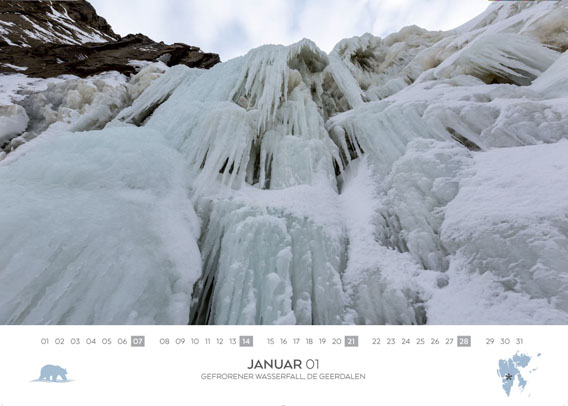
Spitsbergen-Calendar 2018: January. Frozen waterfall.
The Spitsbergen-calender 2018: northern lights over Longyearbyen in December
The northern light is for the polar night what the polar bears are for the summer: everybody wants to see them. The northern light, or Aurora borealis, is indeed a majestic phenomenon! If you have ever seen a real one, you will for sure not forget it. There is an info page about northern lights and northern light photography on this website, by the way. The season is about to begin.
Actually, Longyearbyen is not even the best place to see northern lights. If you are on an Aurora mission, then northern Scandinavia may be just as good, if not better. But of course you can see fantastic northern lights in Spitsbergen! With some luck, you can even see then mid-day. This dayside aurora is comparatively rare, but they do happen. Hard to believe, but true! This requires real darkness 24 hours a day, and that is what you get in Longyearbyen from late November to early January.
The December-photo of our Spitsbergen-calendar 2018 was taken early evening. We went around in Longyearbyen with a TV team and they wanted norhtern lights – of course. Risky business if you don’t have more time than just a very few days! Maybe you are lucky, maybe not … both the weather and the aurora activity have to be on your side. We had already been around for a long evening without seeing more than dark clouds. A day later, things were more promising. And suddenly, the sky exploded over Longyearbyen! It was indeed one of my better Aurora moments in Spitsbergen. The photo does not even show the strongest northern light of that evening, but Lady Aurora was dancing above this part of the iconic coal cableway and Platåberget, a very characteristic and well-known mountain right next to Longyearbyen.
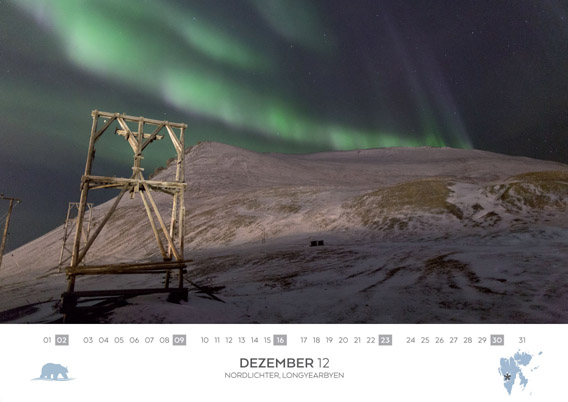
Spitsbergen-Calender 2018: December. Northern light above Longyearbyen.
Born in Sauna: Alexander Lembke’s Sauna exhibition opened in Tampere
Alexander Lembke is well known to many who have travelled with us in recent years in Spitsbergen. Many have heard about his project of science, photography and practical use of the Finnish sauna.
Now, the project has reached a (preliminary) climax: the exhibition “Sauna Syntyneet (Born in Sauna)” was opened on Friday, October 13, in Tampere in Finland. The exhibition was supported by organizations including the Goethe-Institut, the town of Tampere and the Finnish Sauna Society. Their representatives were present at the opening and held speaches.
Alexander’s work is about the important role of sauna in Finnish culture, history and society. The current exhibition is about people who were actually born in a sauna. A sauna is regularly heated and cleaned and it is a place of spirituality, which altogether makes it a place well suited of events such as giving birth. People were born in sauna in Finland also in recent years, also it is much less common than in the more distant past. The exhibition shows large portraits of people who were born in sauna. In poetic films, they tell their stories about their individual relationship to the sauna and their sauna rituals. The youngest person portraited in the exhibition is 5 years old now, the oldest one is 102! Some of these people, who were born in sauna, were present during the opening.
If you happen to come to Tampere until November 24, 2017, then you have got the opportunity to visit the exhibition “Saunassa Syntyneet (Born in Sauna)”.
Alexander Lembke during the opeing of the exhibition “Saunassa Syntyneet (Born in Sauna)” on Friday in Tampere.
News-Listing live generated at 2024/April/20 at 12:33:12 Uhr (GMT+1)
